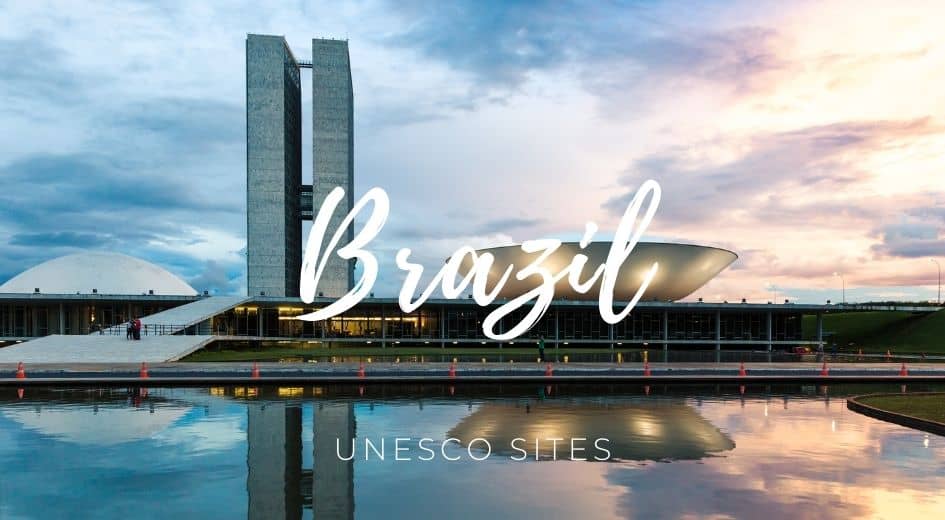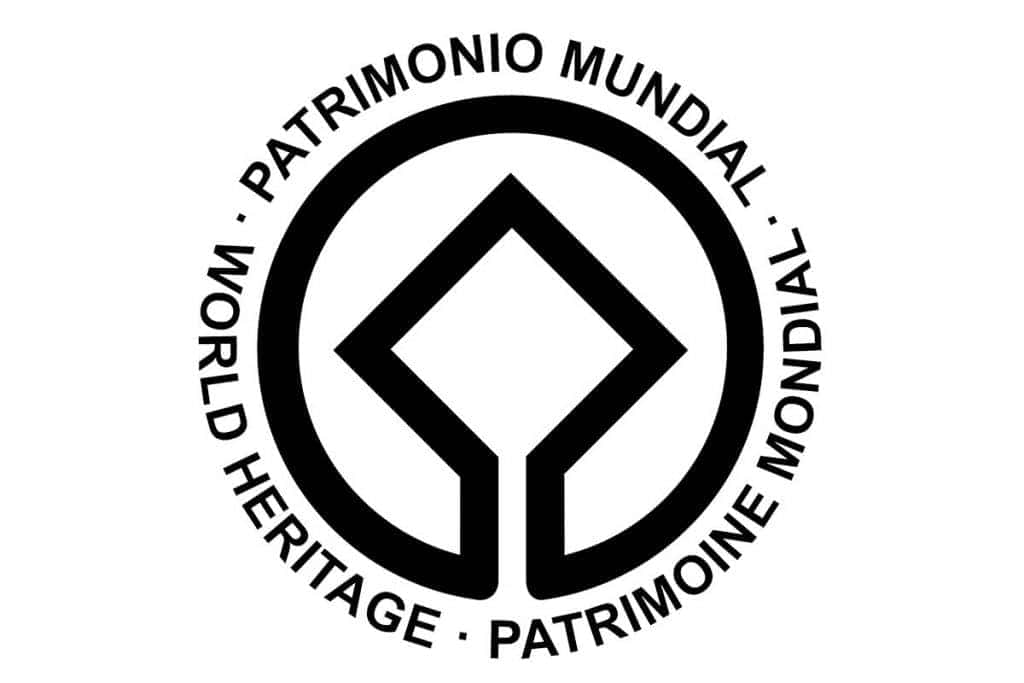Table of Contents


Brazil UNESCO has registered 23 sites on the World Heritage list and 21 on the tentative list.
Some places are so interesting that it’s relevant to keep them for future generations. This is why UNESCO has built a list of crucial classified properties in which superb places stand out for their aesthetic, natural, artistic, or cultural significance.
More than a thousand places are registered as Unesco’s World Heritage worldwide. Due to my interest in visiting World Heritage sites, I compiled the UNESCO list in Brazil and the corresponding map.
Brazil UNESCO list
- Brasilia
- Historic Centre of Salvador de Bahia
- Historic Centre of São Luís
- Historic Centre of the Town of Diamantina
- Historic Centre of the Town of Goiás
- Historic Centre of the Town of Olinda
- Historic Town of Ouro Preto
- Jesuit Missions of the Guaranis: San Ignacio Mini, Santa Ana, Nuestra Señora de Loreto and Santa Maria Mayor (Argentina), Ruins of Sao Miguel das Missoes (Brazil)
- Pampulha Modern Ensemble
- Rio de Janeiro: Carioca Landscapes between the Mountain and the Sea
- Sanctuary of Bom Jesus do Congonhas
- São Francisco Square in the Town of São Cristóvão
- Serra da Capivara National Park
- Sítio Roberto Burle Marx
- Valongo Wharf Archaeological Site
- Atlantic Forest South-East Reserves
- Brazilian Atlantic Islands: Fernando de Noronha and Atol das Rocas Reserves
- Central Amazon Conservation Complex
- Cerrado Protected Areas: Chapada dos Veadeiros and Emas National Parks
- Discovery Coast Atlantic Forest Reserves
- Iguaçu National Park
- Pantanal Conservation Area
- Paraty and Ilha Grande – Culture and Biodiversity
Brazil UNESCO Map
Click on the blue pins to view more relevant information about each World Heritage site in Brazil.
Description
- Brasilia: The capital city of Brazil, designed by architect Oscar Niemeyer and urban planner Lucio Costa, and built from scratch in the late 1950s to early 1960s, showcasing modernist architecture and urban planning.
- Historic Centre of Salvador de Bahia: The historic center of the city of Salvador, the former colonial capital of Brazil, featuring well-preserved Baroque architecture, religious and civic buildings, and a rich Afro-Brazilian cultural heritage.
- Historic Centre of São Luís: The historic center of the city of São Luís, featuring a unique blend of Portuguese, African, and indigenous cultural influences reflected in its architecture, urban layout, and cultural practices.
- Historic Centre of the Town of Diamantina: A former diamond-mining town in Minas Gerais featuring well-preserved colonial-era architecture, religious and civic buildings, and cultural traditions.
- Historic Centre of the Town of Goiás: A former colonial capital of the state of Goiás, featuring well-preserved colonial-era architecture, religious and civic buildings, and cultural traditions.
- Historic Centre of the Town of Olinda: A colonial-era town in Pernambuco featuring well-preserved Baroque architecture, religious and civic buildings, and a rich Afro-Brazilian cultural heritage.
- Historic Town of Ouro Preto: A former colonial capital of Minas Gerais, featuring well-preserved colonial-era architecture, religious and civic buildings, and cultural traditions.
- Jesuit Missions of the Guaranis: A collection of religious and cultural sites in Brazil and Argentina established by the Jesuits in the 17th and 18th centuries and reflected the unique blend of European and indigenous cultures that have shaped the region over the centuries.
- Pampulha Modern Ensemble: A group of modernist buildings designed by Brazilian architect Oscar Niemeyer, located in Belo Horizonte, featuring innovative designs and artistic collaborations.
- Rio de Janeiro: Carioca Landscapes between the Mountain and the Sea: A cultural landscape encompassing several landmarks in Rio de Janeiro, including the Christ the Redeemer statue, Sugarloaf Mountain, and historic neighborhoods and parks.
- Sanctuary of Bom Jesus do Congonhas: A religious complex in Minas Gerais featuring Baroque architecture, sculptures, and religious artwork.
- São Francisco Square in the Town of São Cristóvão: A historic square and cultural center located in the town of São Cristóvão, featuring Baroque and neoclassical architecture, religious and civic buildings, and cultural traditions.
- Serra da Capivara National Park: A protected area in Piauí featuring well-preserved prehistoric rock art, archaeological sites, and unique biodiversity.
- Sítio Roberto Burle Marx: A botanical garden and a cultural site near Rio de Janeiro featuring a unique collection of tropical plants and artistic landscapes designed by Brazilian landscape architect Roberto Burle Marx.
- Valongo Wharf Archaeological Site: An archaeological site located in the port area of Rio de Janeiro, featuring well-preserved evidence of the transatlantic slave trade and its impact on Brazilian society and culture.
- Atlantic Forest South-East Reserves: A network of protected areas in Brazil’s southeastern Atlantic Forest region featuring unique biodiversity and ecosystem services.
- Brazilian Atlantic Islands: Fernando de Noronha and Atol das Rocas Reserves: A network of protected areas on several islands off the Brazilian coast featuring unique biodiversity and cultural heritage.
- Central Amazon Conservation Complex: A vast protected area covering over 6 million hectares in the heart of the Amazon rainforest, featuring diverse ecosystems, wildlife, and cultural heritage.
- Cerrado Protected Areas: Chapada dos Veadeiros and Emas National Parks: Two protected areas located in the Cerrado biome, a unique savanna ecosystem in Brazil, featuring diverse flora and fauna, natural landscapes, and cultural heritage.
- Discovery Coast Atlantic Forest Reserves: A network of protected areas located in the Atlantic Forest biome along the coast of Bahia, featuring unique biodiversity and cultural heritage associated with the discovery and colonization of Brazil.
- Iguaçu National Park: A protected area on the border between Brazil and Argentina, featuring one of the world’s most spectacular waterfalls, a unique subtropical forest ecosystem, and cultural heritage.
- Pantanal Conservation Area: A vast protected area covering over 180,000 hectares in the Pantanal wetlands, featuring diverse wildlife, ecosystems, and cultural heritage associated with traditional ranching and fishing practices.
- Paraty and Ilha Grande – Culture and Biodiversity: A cultural landscape encompassing several historic towns, natural landscapes, and cultural practices associated with the colonial-era coffee trade and Afro-Brazilian cultural heritage.
UNESCO World Heritage Sites in Brazil are protected places for their cultural and natural importance.
Sites on the Tentative List
- Eglise et Monastère de Sao Bento, Rio de Janeiro
- Palais de la Culture, ancien siège du Ministère de l’Education et de la Santé, Rio de Janeiro
- Parc national du Pico da Neblina (Amazonas)
- Parc national de la Serra da Bocaina (São Paulo – Rio de Janeiro)
- Réserve biologique d’Atol das Rocas (Rio Grande do Norte)
- Station écologique de Taim (Rio Grande do Sul)
- Station écologique du Raso da Catarina (Bahia)
- Canyon du Rio Peruaçu, Minas Gerais
- Anavilhanas Ecological Station
- Serra do Divisor National Park
- Serra da Canastra National Park
- Cavernas do Peruaçu Federal Environmental Protection Area (APA) / Veredas Do Peruaçu State Park
- Serra da Capivara National Park and Permanent Preservation Areas
- Cultural Landscape of Paranapiacaba: Village and railway systems in the Serra do Mar Mountain Range, São Paulo
- Ver-o-Peso
- Amazonia Theaters
- Brazilian Fortresses Ensemble
- Cedro Dam in the Quixadá Monoliths
- Geoglyphs of Acre
- Itacoatiaras of Ingá River
- Parque Nacional dos Lençóis Maranhenses – Lençóis Maranhenses National Park


